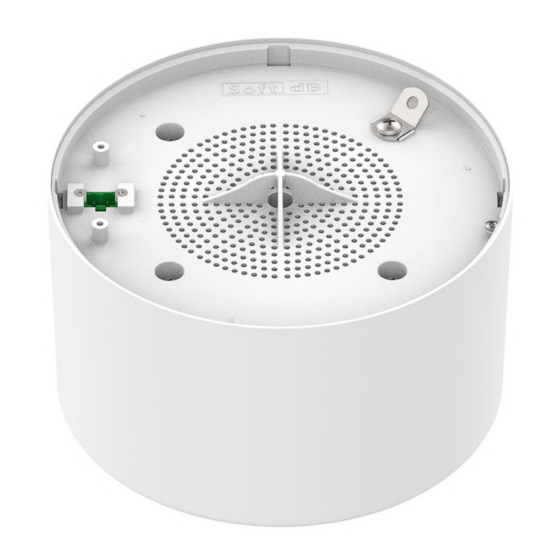
Summary of Contents for SoftdB SMS-STX
- Page 1 SMS-STX Sound Masking Speaker User Guide V01_20220418 Soft dB Inc. 1040, Belvedere Avenue, Suite 215 Quebec (Quebec) Canada G1S 3G3 Toll free: 1-866-686-0993 (USA and Canada) E-mail: info@softdb.com...
- Page 2 Content Overview ..........................2 Specifications ........................3 Installation ......................... 4 Safety Instructions ..........................4 Securing the Speaker .......................... 5 Connecting the Speaker ........................6 SMS-STXATT Attenuator ........................7...
- Page 3 1 Overview The SMS-STX loudspeaker is designed to generate the optimum masking sound for a variety of ceiling conditions. It is typically used in open ceiling configuration, but it can also be installed in the plenum space, suspended between the acoustical tiles and the deck.
- Page 4 2 Specifications Specifications Power 10W Impedance 75 Ohms Line Voltage 25 V Sensitivity 92 dB Enclosure Material Lexan Polycarbonate plastic Frequency Response 100 Hz to 10 kHz Connectors Phoenix Screw Connector Driver 11 cm (4.5”) full range Color White (RAL9016) Anchor Device 5mm plastic hook at the center Seismic Security Additional 5mm metal hook Certification UL 62368 in process...
- Page 5 3 Installation 3.1 Safety Instructions Read and keep these instructions. • Heed all warnings and follow all instructions contained within this manual. • Install in accordance with the manufacturer’s instructions. • Clean only with dry cloth. • Do not install near water. •...
- Page 6 3.2 Securing the Speaker Hang the speaker to the deck using a chain, a metal wire or any other appropriate device attached to the center hook of the speaker. Use an anchor of sufficient strength to support the weight of the speaker. If the regulations require a second safety anchor, you can use the black safety hanger.
- Page 7 3.3 Connecting the Speaker All wiring should be carried out with 2-conductor stranded copper wire. The minimum wire calibre is 18 AWG (1mm ). Wire size to be specified by the designer of the installation. Follow local regulation for wiring requirements. EXTERNAL CONNECTION: The speakers are connected in parallel, in a daisy-chain configuration.
- Page 8 3.4 SMS-STXATT Attenuator If you need to attenuate the sound output from a single speaker, you can use the SMS- STXATT attenuator (Available separately). This allows you to add a 3 dB and 6 dB attenuation on the signal sent to the speaker. Simply unplug the phoenix connector, and connect the phoenix in the right input.



Need help?
Do you have a question about the SMS-STX and is the answer not in the manual?
Questions and answers